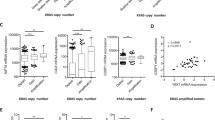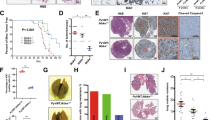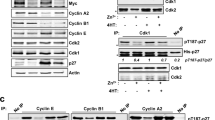Abstract
PKR is a double-stranded (ds) RNA activated protein kinase whose expression is induced by interferon. Activated PKR phosphorylates its cellular substrate, eIF2, an essential initiation factor of translation. Prior evidence from a murine model system suggested that PKR may act as a tumor suppressor, but the evidence from human tumors is equivocal. To study PKR function in human breast cancer, PKR activity was measured in mammary carcinoma cell lines and nontransformed mammary epithelial cell lines. If PKR functioned as a tumor suppressor in this system, its activity would be higher in nontransformed cells than in carcinoma cells. On the contrary, PKR autophosphorylation and the phosphorylation of its substrate, the α-subunit of eIF2, is 7–40-fold higher in lysates prepared from breast carcinoma cell lines than in those from nontransformed epithelial cell lines. Correspondingly, a larger proportion of eIF2α is present in a phosphorylated state in carcinoma cell lines than in nontransformed cell lines. Protein synthesis is not inhibited by the high eIF2α phosphorylation in carcinoma cells, probably because they contain higher levels of eIF2B, the initiation factor that is inhibited by eIF2α phosphorylation. The dramatically lower PKR activity in nontransformed cell lines is partially due to lower PKR protein levels (2–4-fold) as well as to the presence of a PKR inhibitor. The nontransformed cells contain P58, a known cellular inhibitor of PKR that physically interacts with PKR and may be responsible for the low PKR activity in these cells. Taken together, these observations call into question the role of PKR as a tumor suppressor and suggest a positive regulatory role of PKR in growth control of breast cancer cells.
This is a preview of subscription content, access via your institution
Access options
Subscribe to this journal
Receive 50 print issues and online access
$259.00 per year
only $5.18 per issue
Buy this article
- Purchase on Springer Link
- Instant access to full article PDF
Prices may be subject to local taxes which are calculated during checkout





Similar content being viewed by others
References
Abraham N, Stojdl DF, Duncan PI, Methot N, Ishii T, Dube M, Vanderhyden BC, Atkins HL, Gray DA, McBurney MW, Koromilas AE, Brown EG, Sonenberg N and Bell JC. . 1999 J. Biol. Chem. 274: 5953–5962.
Balachandran S, Kim CN, Yeh WC, Mak TW, Bhalla K and Barber GN. . 1998 EMBO J. 17: 6888–6902.
Barber GN, Thompson S, Lee TG, Strom T, Jagus R, Darveau A and Katze MG. . 1994 Proc. Natl. Acad. Sci. USA 91: 4278–4282.
Basu S, Panayiotidis P, Hart SM, He LZ, Man A, Hoffbrand AV and Ganeshaguru K. . 1997 Cancer Res. 57: 943–947.
Benkirane M, Neuveut C, Chun RF, Smith SM, Samuel CE, Gatignol A and Jeang KT. . 1997 EMBO J. 16: 611–624.
Beretta L, Gabbay M, Berger R, Hanash SM and Sonenberg N. . 1996 Oncogene 12: 1593–1596.
Brand SR, Kobayashi R and Mathews MB. . 1997 J. Biol. Chem. 272: 8388–8395.
Chong KL, Feng L, Schappert K, Meurs E, Donahue TF, Friesen JD, Hovanessian AG and Williams BRG. . 1992 EMBO J. 11: 1553–1562.
Clemens MJ and Elia A. . 1997 J. Inter. Cyto. Res. 17: 503–524.
Der SD, Yang YL, Weissmann C and Williams BR. . 1997 Proc. Natl. Acad. Sci. USA 94: 3279–3283.
Donze O, Dostie J and Sonenberg N. . 1999 Virology 256: 322–329.
Donze O, Jagus R, Koromilas AE, Hershey JW and Sonenberg N. . 1995 EMBO J. 14: 3828–3834.
Green SR and Mathews MB. . 1992 Genes Dev. 6: 2478–2490.
Gunnery S and Mathews MB. . 1998 Methods 15: 189–198.
Haines GK, Cajulis R, Hayden R, Duda R, Talamonti M and Radosevich JA. . 1996 Tumour Biol. 17: 5–12.
Haines GK 3rd, Panos RJ, Bak PM, Brown T, Zielinski M, Leyland J and Radosevich JA. . 1998 Tumour Biol. 19: 52–59.
Harlow E and Lane D. . 1998 Antibodies: a laboratory manual. Cold Spring Harbor Laboratory: Cold Spring Harbor.
Jaramillo ML, Abraham N and Bell JC. . 1995 Cancer Invest. 13: 327–338.
Koromilas AE, Roy S, Barber GN, Katze MG and Sonenberg N. . 1992 Science 257: 1685–1689.
Kumar A, Yang YL, Flati V, Der S, Kadereit S, Deb A, Haque J, Reis L, Weissmann C and Williams BR. . 1997 EMBO J. 16: 406–416.
Laemmli UK. . 1970 Nature (London) 227: 680–685.
Langland JO, Kao PN and Jacobs BL. . 1999 Biochemistry 38: 6361–6368.
Lee SB, Rodriguez D, Rodriguez JR and Esteban M. . 1997 Virology 231: 81–88.
Lee TG, Tang N, Thompson S, Miller J and Katze MG. . 1994 Mol. Cell. Biol. 14: 2331–2342.
Maran A, Maitra RK, Kumar A, Dong B, Xiao W, Li G, Williams BR, Torrence PF and Silverman RH. . 1994 Science 265: 789–792.
Meurs EF, Galabru J, Barber GN, Katze MG and Hovanessian AG. . 1993 Proc. Natl. Acad. Sci. USA 90: 232–236.
Mundschau LJ and Faller DV. . 1995 J. Biol. Chem. 270: 3100–3106.
Offermann MK, Zimring J, Mellits KH, Hagan MK, Shaw R, Medford RM, Mathews MB, Goodbourn S and Jagus R. . 1995 Eur. J. Biochem. 232: 28–36.
Oldfield S, Jones BL, Tanton D and Proud CG. . 1994 Eur. J. Biochem. 221: 399–410.
Patel RC, Vestal DJ, Xu Z, Bandyopadhyay S, Guo W, Erme SM, Williams BR and Sen GC. . 1999 J. Biol. Chem. 274: 20432–20437.
Pavitt GD, Ramaiah KV, Kimball SR and Hinnebusch AG. . 1998 Genes Dev. 12: 514–526.
Polyak SJ, Tang N, Wambach M, Barber GN and Katze MG. . 1996 J. Biol. Chem. 271: 1702–1707.
Reichel PA, Merrick WC, Siekierka J and Mathews MB. . 1985 Nature 313: 196–200.
Romano PR, Garcia-Barrio MT, Zhang X, Wang Q, Taylor DR, Zhang F, Herring C, Mathews MB, Qin J and Hinnebusch AG. . 1998 Mol. Cell Biol. 18: 2282–2297.
Savinova O and Jagus R. . 1997 Methods 11: 419–425.
Shimada A, Shiota G, Miyata H, Kamahora T, Kawasaki H, Shiraki K, Hino S and Terada T. . 1998 Cancer Res. 58: 4434–4438.
Tang NM, Korth MJ, Gale Jr M, Wambach M, Der SD, Bandyopadhyay SK, Williams BR and Katze MG. . 1999 Mol. Cell Biol. 19: 4757–4765.
Williams BR. . 1997 Biochem. Soc. Trans. 25: 509–513.
Yang YL, Reis LF, Pavlovic J, Aguzzi A, Schafer R, Kumar A, Williams BR, Aguet M and Weissmann C. . 1995 EMBO J. 14: 6095–6106.
Yeung MC and Lau AS. . 1998 J. Biol. Chem. 273: 25198–25202.
Zamanian-Daryoush M, Der SD and Williams BR. . 1999 Oncogene 18: 315–326.
Acknowledgements
This work was supported by seed grant from the Dean's Biomedical Research Fund RA3467 and by NIH grant AI34552. We would like to thank R Wieder, M Clemens, JWB Hershey, M Katze and C Proud for cell lines and other essential reagents.
Author information
Authors and Affiliations
Rights and permissions
About this article
Cite this article
Kim, S., Forman, A., Mathews, M. et al. Human breast cancer cells contain elevated levels and activity of the protein kinase, PKR. Oncogene 19, 3086–3094 (2000). https://doi.org/10.1038/sj.onc.1203632
Received:
Revised:
Accepted:
Published:
Issue Date:
DOI: https://doi.org/10.1038/sj.onc.1203632
Keywords
This article is cited by
-
Therapeutic effects of the PKR inhibitor C16 suppressing tumor proliferation and angiogenesis in hepatocellular carcinoma in vitro and in vivo
Scientific Reports (2020)
-
Translational downregulation of Twist1 expression by antiproliferative gene, B-cell translocation gene 2, in the triple negative breast cancer cells
Cell Death & Disease (2019)
-
Exosomal packaging of trans-activation response element (TAR) RNA by HIV-1 infected cells: a pro-malignancy message delivery to cancer cells
Molecular Biology Reports (2019)
-
Smad7 knockdown activates protein kinase RNA-associated eIF2α pathway leading to colon cancer cell death
Cell Death & Disease (2017)
-
OSU-03012 sensitizes breast cancers to lapatinib-induced cell killing: a role for Nck1 but not Nck2
BMC Cancer (2013)



